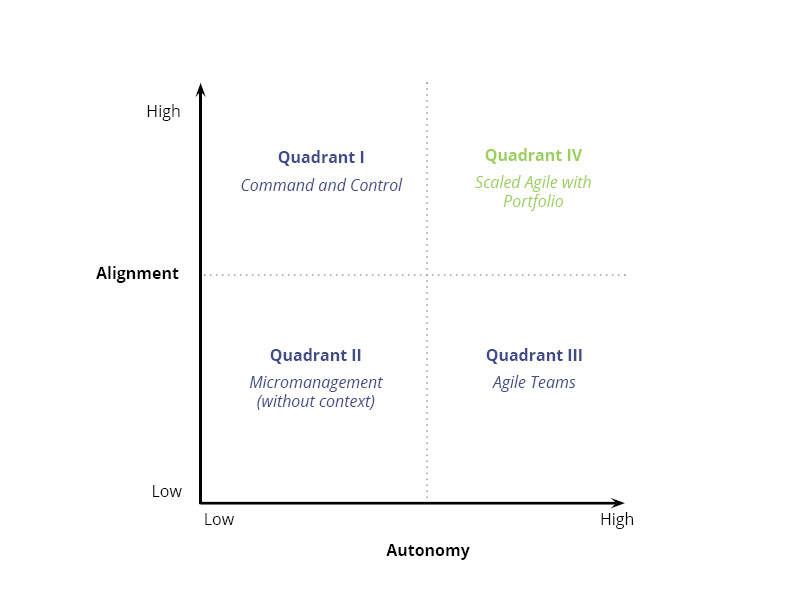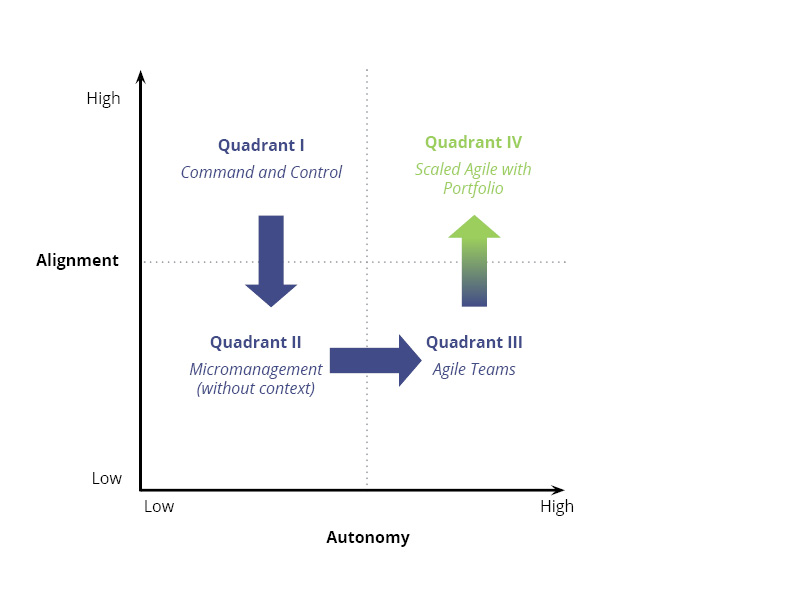

In the third part of this mini-series about the role of autonomy and alignment in transformation, we’re talking about balancing the two, some of the signs that you’re not quite there yet, and what you can do about it.
If we look at autonomy and alignment like a chart with two dimensions, there are four different quadrants your organization could be in.

I) Low autonomy, high alignment
Also known as command and control. A leader or leadership team identified a problem to solve and has a vision of the to-be state. They created a plan to get there and assigned out the pieces of the solution that each team needs to execute.
This organization may make quick progress but the leader is the bottleneck. Teams understand the bigger vision but may not feel empowered to explore alternative solutions, identify new opportunities, or make decisions without a go-ahead from above.
II) Low autonomy, low alignment
Micro-management with no context. Teams are given tasks with no linkage to other teams or the broader picture. Signs that you’re here are if team decisions are often overturned, or if leaders on the teams are asking for the vision or goals they should be working toward. That’s a signal that they have the how but not enough of the what or the why. Progress may be fast, but the organization can’t pivot or deal with changes well.
III) High autonomy, low alignment
Teams have the power and flexibility to go in whichever direction they choose, but the teams aren’t collaborating or contributing to the broader strategic goals of the company. Teams are equipped to make their own decisions but their actions and outcomes don’t line up with other teams. This scenario is typical when enterprises have a set of agile teams but haven’t yet worked out how to coordinate their actions to achieve something bigger.
The gap can also be between the tactical and strategic layers. People on the ground can deliver and executives can define strategy but the organization has trouble converting that strategy to results in the real world. Each group is autonomous but there isn’t alignment between strategy and tactics.
IV) High autonomy, high alignment
Each team can make their own decisions while seeing how it fits into the broader strategy. Everyone helps shape the strategy. It’s clear who can make which decisions, when, and how. Who needs to work with whom, when. You’re balancing the advantages of consistency and shared understanding with the benefits of experimentation and learning.
This is the result of applying a portfolio management strategy. Each group knows what’s going on above, below, and on peer teams. They understand how their work fits into the broader roadmap and goals. But they also have the flexibility to design how they complete their work and what they work on. They can gather insights to share with others, potentially shifting the shared course of action.
Some of the characteristics of organizations blending high autonomy with high alignment
They build shared consciousness
By encouraging visibility so that employees have access to all business information and objectives. Open access to information allows them to foster an organization of mini-CEOs. People who take charge to achieve the big objectives, given their role in the organization. Some organizations go to the extreme and make all information open to employees, including company financials.
They have clear objectives for each level and team, that are linked together
Teams are organized and judged by their contribution to business objectives, not the number of features they release. The organization aligns personal, team, and enterprise goals.
Their strategic planning doesn’t just happen in the executive conference room
They have collaborative processes for shaping the future of their enterprise. That take into account perspectives and insights from all angles so that the organization can execute the strategy successfully.
They manage their work like they’re building a system
Leaders and creators pay extra attention to system dynamics and architecture because they know that the whole doesn’t equal the sum of the parts. And that the events you easily see are just a symptom of what’s going on under the surface.
They evolve their processes and try out new ideas
The organization sets some guidelines to start and then changes their shared practices and standards given feedback. They work in cycles with frequent retrospectives to examine what’s working and what’s not. And they regularly experiment with their processes for working together and individually, to see if they can land on a better solution.
The typical path
Organizations can start out anywhere on this chart, but one common path is to start in the top or bottom left quadrant and move around counter-clockwise.
They begin with command and control, but then break apart responsibility into separate teams. The goal was to improve autonomy, but they may just end up decreasing alignment and connection to the broader context.
Then they encourage more autonomy on the teams and the team members begin to figure out a groove for working together. Eventually, they become functioning agile teams.
Finally, the enterprise learns that having separate autonomous teams without alignment is not enough to achieve their big goals, so they look for ways to increase alignment, without reverting back to command and control.
Are you on that path? Would you like to get to high-autonomy and high-alignment faster? We help organizations make their way to that quadrant. View our services and book your free consult call to discuss your organization and the next steps here.
Which quadrant is your organization in?